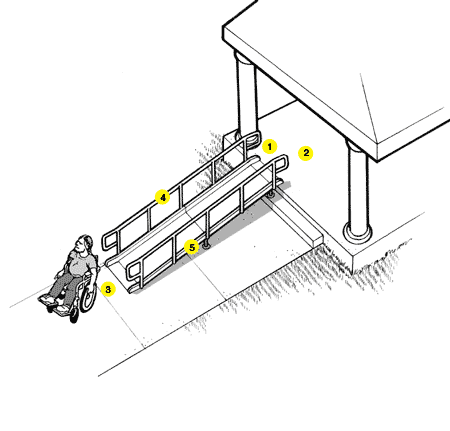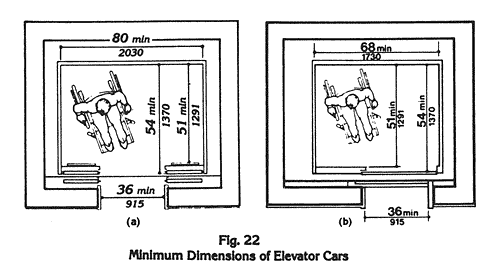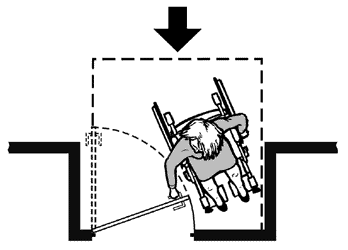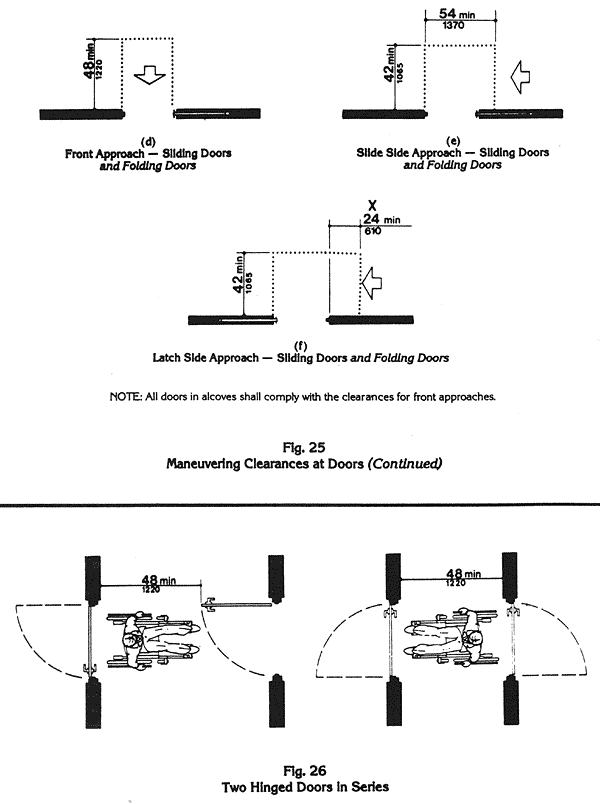| U.S. Department of Justice Civil Rights Division Disability Rights Section |
|
Americans with Disabilities Act
ADA Checklist for Polling Places

February 2004
![]()
Reproduction
Reproduction of this document is encouraged.
Additional copies of this publication may be obtained, viewed or downloaded
from the Publications section of the ADA Website (www.ada.gov)
or by calling the ADA Information Line at
800-514-0301 (voice), 833-610-1264 (TTY).
Disclaimer
The ADA authorizes the Department of Justice to provide technical assistance
to individuals and entities that have rights or responsibilities under the Act.
This document provides informal guidance to assist you in understanding the ADA
and the Department's regulation. However, this technical assistance
does not constitute a legal interpretation of the statute.
February 2004
![]()
Table of Contents
Evaluating the Physical Accessibility of Polling Places - 1
Getting Started ...................................................... 2
Using the Polling Place Checklist - 2
Taking Measurements - 3
Completing the Checklist - 4
After Completing the Survey - 4
Getting to the Polling Place - 5
A. Parking ............................................................. 5
Typical Issues - 5
Parking Checklist - 6
Temporary Solutions for Election Day - 8B. Passenger Drop-Off Areas ............................... 9
Typical Issues - 9
Passenger Drop-Off Areas Checklist - 10
Temporary Solutions for Election Day - 11C. Sidewalks and Walkways ............................... 12
Part 1. Typical Issues for Voters Who Use Wheelchairs, Scooters,
or Other Mobility Aids - 12Sidewalks and Walkways Checklist - 13
Temporary Solutions for Election Day - 15
Part 2. Typical Issues for Voters Who Are Blind or Have Low Vision - 16
Sidewalks and Walkways Checklist - 17
Temporary Solutions for Election Day - 18
Entering the Polling Place - 19
D. Building Entrance .......................................... 19
Typical Issues - 19
Building Entrance Checklist - 20
Temporary Solutions for Election Day - 22
E. Hallways and Corridors ................................ 23
Part 1. Typical Issues for Voters Who Use Wheelchairs, Scooters, or Other Mobility Devices - 23Halls and Corridors Checklist - Voters with Mobility Disabilities - 24
Temporary Solutions for Election Day - 28Part 2. Typical Issues for Voters who are Blind or Who Have Low Vision - 29
Halls and Corridors Checklist - Voters who are Blind or Who Have Low Vision - 30
Temporary Solutions for Election Day - 31
Using the Polling Place - 32
F. Voting Area ........................................................... 32
Typical Issues - 32
Voting Area Checklist - 33
Appendix - A-1
![]()
Evaluating the Physical Accessibility of Polling Places
When choosing a new site for a polling place, elections officials should select a facility that is accessible to voters who use wheelchairs or scooters or who have difficulty walking. Planning for an upcoming election also gives elections officials the opportunity to improve existing polling places that are not accessible by using temporary elements, such as portable ramps, on election day or by working with building owners to make permanent alterations that improve the accessibility of the polling place.
The following checklist is designed to help voting officials determine whether a polling place has basic accessible features needed by most voters with disabilities. It may be used when evaluating the accessibility of potential new polling places and when identifying physical barriers in existing polling places before temporary or permanent modifications are made to improve accessibility for elections.
Individuals completing the checklist do not necessarily need to be experienced in evaluating buildings and facilities for accessibility. The checklist is designed to prompt the user to check key features by asking questions about sizes, sloped surfaces, and availability of accessible features, and in some areas it suggests alternatives if a physical barrier is identified. By following the directions provided for filling out the checklist, voting staff and volunteers can identify accessible polling places and develop information used for implementing temporary and permanent modifications.
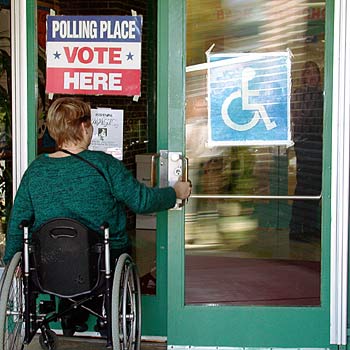
A voter enters an accessible polling place.
Getting Started
An evaluation of polling place accessibility should focus on those areas of a facility that are important to voting. These often include parking for voters, a drop off or loading area, the entrance to the polling place, and the pedestrian routes (both exterior and interior) that voters use to get to the voter check-in and voting area.
Before a polling place is evaluated, it is useful for staff or volunteers to review the instructions for using the checklist and become familiar with the questions. It is also helpful to practice taking measurements and recording information before beginning the evaluation.
When staff arrive at a polling place, it is best to first determine the location of parking, including accessible parking (if any is provided), the entrance that will be used on election day, and the location of the voting area. If the survey is being done to determine the accessibility of a new location for a polling place, then the walk-through should look for areas that provide the best accessibility, where simple modifications may provide accessibility, or where it may be easiest to improve accessibility by adding temporary features.
Using the Polling Place Checklist
Tools and Documentation
A few simple tools may be used to measure the sizes and the slope of specific elements and spaces:
. • A metal tape measure at least 15-feet long
. • A level with a bubble measure or a digital measure at least twenty-four inches long for measuring slope, and
. • A clipboard, copy of the checklist (one copy per polling place), and pens or pencils.
It is also a good idea to have a film or digital camera to document important areas that may need to be reviewed later. Any camera may be used to shoot photographs but one with a flash is most useful, particularly when indoor photos are needed.
Use the Checklist to Record Data
The checklist is designed to prompt the users on what to look at and where to measure. All answers and notes should be recorded on the checklist for use later in the planning process. When completed, the checklist should provide an indication of the level of accessibility at the polling place. If photographs are taken during the survey, it is helpful to note on the checklist that a photo was taken for later review of particular elements, spaces, or conditions.
Completing Measurements and Recording Information
One person can complete a survey of a polling place but it is often quicker and easier for two people to work together. One can be responsible for taking the measurements and the other for recording the information and taking any photographs.
Taking Measurements
Sloped Surfaces
One way to measure slope is to use a 24-inch level with leveling bubble and a tape measure. Place the level on the incline in the direction you wish to measure. Rest one end of the level at the highest point of the sloped surface and lift the other end (as shown in the illustration) until the bubble is in the middle of the tube. This is the “level” position. While the level is in this position, measure the distance between the end of the level and the sloped surface below. If the distance is 2 inches or less, then the slope is 1:12 or less. When the distance is greater than 2 inches, record the distance on the checklist so the exact slope may be calculated later if needed.
Slopes may also be measured using a digital level. The digital display replaces the bubble and typically gives a reading that may be shown as a digital bubble, degrees, or a percent. Before using a digital level make sure to familiarize yourself with the directions. Many digital levels need to be calibrated each time they are used. If you can set the digital display to percent or degrees, the maximum slope generally allowed is 8.33% or 4.76 degrees (for a 1:12 slope).
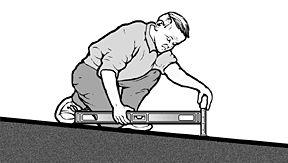
Measuring slope using a 24-inch level and tape measure
Using the Tape Measure
When measuring the width of a parking space or access aisle, the width of an accessible route or the height of an object above the floor, for example, try to keep the tape from sagging or bending. If the tape is not straight, try to support the tape in the middle or pull it tight and take the measurement again.
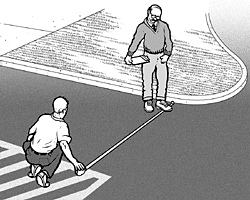
Using a tape measure to measure the width of a parking space
Measuring Door Openings
Measuring the clear opening of an accessible door requires special care. To measure the opening of a standard hinged door, open the door to 90 degrees. Place the end of the tape measure on the side of the door frame next to the clear opening (as shown in the drawing). Stretch the tape across the door opening to the face of the door. This measurement equals the clear open width of the door, which is typically less than the width of the door.
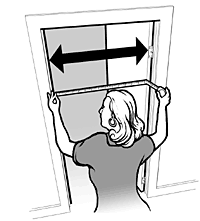
Measuring the clear opening from the face of the doorstop
on the frame to the face of the open door
Completing the Checklist
For each checklist item, check either “yes” or “no.” If the measurement or number falls short of that required for accessibility, write the measurement or number to the right of the question in the area under “Comments.” Add notes or comments as needed. For some questions when “no” is the answer, the checklist will include a prompt to check for an alternate solution. Information on alternate access can be used later as voting officials decide how to provide accessible voting.
When completing the survey, it is important to try to answer every question in each section, unless, of course, the element is not present at the particular site under review. For example, if there is no parking provided on-site at the polling place, or only on-street parking is provided, there is no need to try to measure the size of the parking spaces or to count the number of parking spaces.
The checklist is based on requirements from the ADA Standards for Accessible Design (Standards). Each item includes a reference to the technical requirements in the Standards from 28 C.F.R. Part 36, Appendix A. This reference is provided to assist users in looking up the requirement or related requirements when necessary. An electronic copy of the Standards is available on the ADA Website at archive.ada.gov. Printed copies are also available from the ADA Information Line at 800-514-0301 (voice) or 833-610-1264 (TTY).
After Completing the Survey
Completed polling place surveys will provide the information needed to determine which sites are accessible and which may become accessible with permanent or temporary modifications. Checklists where most answers are “yes” will usually indicate an accessible polling place. Others, where some answers are “no,” may become accessible if permanent or temporary modifications are done to remove barriers. Polling places in older buildings may have few accessible features but some of these voting facilities may be able to be made accessible with temporary modifications, such as portable ramps at the entrance and accessible parking spaces marked off by traffic cones. There may also be some sites that cannot be made accessible so plans will be needed to offer accessible voting in some other way.For more information about temporary modifications, see Temporary Solutions for Election Day at the end of each section of this document.
Alterations
When State and local governments make permanent modifications or alterations to facilities that serve as polling places these alterations must comply with the ADA Standards. For more information visit the ADA Website to view or download the ADA Standards, technical assistance materials, and general ADA information.
archive.ada.gov
For specific questions about the ADA, call the Department of Justice ADA Information Line.
800-514-0301 (voice)
833-610-1264 ( TTY)
Getting to the Polling Place
A. Parking
Typical Issues
When parking is provided for voters, staff and volunteers, accessible parking must be provided for people with disabilities. Voters with disabilities who arrive by car need a parking space close to an accessible entrance. The accessible parking space has an adjacent access aisle that provides needed room for a person to open the car door fully and then stand with the aid of a walker, to transfer to a wheelchair, or to lower a wheelchair lift. The access aisle connects directly to an accessible route that leads to an accessible building entrance. In order to be usable, the access aisle must be relatively level, clear of gravel or mud, and the surface must be in good condition without wide cracks or broken pavement.
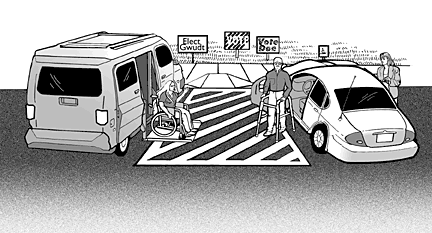
Van-accessible parking spaces serve both cars and vans. A wide access aisle is needed
so a wheelchair lift may be lowered from the van onto the level surface.
An accessible route connects the access aisle of each accessible parking space with the accessible entrance to the polling place. When an accessible route crosses a curb, a curb ramp must be provided. If the accessible route connects the access aisle to the accessible entrance using the parking lot surface, a marked crosswalk should be provided on the vehicular route.

Parking Spaces Checklist
A1. If parking is available, count the total number of parking spaces provided for the
polling place. Are the minimum number of accessible parking spaces provided, based
on the total number of available parking spaces (see table below)?
Yes _____ No _____
| Total Spaces for Polling Place | Required Minimum Number of Accessible Spaces |
| 1-25 | 1 van-accessible space w/ min. 96 inch wide access aisle |
| 26-50 | 1 space w/ min. 60 inch wide access aisle + 1 van-accessible space |
| 51-75 | 2 spaces w/ min. 60 inch wide access aisle + 1 van-accessible space |
If more than 75, see the ADA Standards for Accessible Design, section 4.1.2, for the number of
accessible parking spaces.
A2. Does each accessible parking space have its own, or share an adjacent access
aisle that is least 60 inches (5 feet) wide? [ADA Stds 4.6.3]
Yes _____ No _____
A3. Is there at least one van-accessible parking space provided with an access aisle
that is at least 96 inches (8 feet) wide or are universal parking spaces provided with a
132 inches (11feet) wide vehicle space and a 60 inch (5 feet) wide access aisle?
[ADA Stds 4.1.2(5), A4.6]
Yes _____ No _____
A4. For van-accessible spaces, is there vertical clearance of at least 98 inches (8 feet -
2 inches) for the vehicle route to the parking space, the parking space, the access aisle
and along the vehicle route to the exit? [ADA Stds 4.6.5]
If No: Can the route be cleared by removing or raising low objects or can each van accessible
Yes _____ No _____
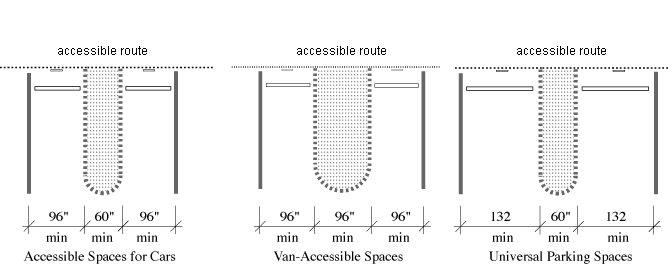
Plan Views of Accessible Parking Spaces Showing Minimum Width of Vehicle Space and Access Aisle.
A5. Are all accessible parking spaces, including the access aisle, relatively level (1:50
or 2%) in all directions? [ADA Stds 4.6.3]
If No: Look for a nearby area that is relatively level which could serve as an accessible parking space
with an accessible route to the accessible entrance to voting.
Yes _____ No _____
A6. Does each accessible parking space have a sign with the symbol of accessibility
that is visible when a vehicle is parked in the space? [ADA Stds 4.6.4]
Yes _____ No _____
A7. If there is a curb between the access aisle and the accessible route to the building,
is there a curb ramp that meets the following requirements: [ADA Stds 4.7]
a. Is the ramp surface at least 36” wide, excluding flared sides?
[ADA Stds 4.7.3]
Yes _____ No _____
b. Is the slope (up or down the ramp) no more than 1:12?
[ADA Stds 4.7.2]
Note: 1:12 is one inch of vertical height for each 12 inches in length.Yes _____ No _____
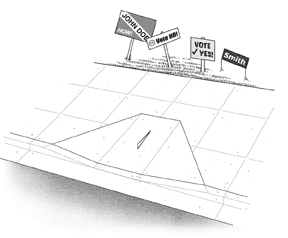
Curb ramp showing minimum 36 inch width for
ramp section and 1:12 slope on ramp section.
A8. Are the accessible parking spaces serving the voting area on the shortest
accessible route to the accessible entrance? [ADA Stds 4.6.2]
Yes _____ No _____
A9. Does each access aisle connect to an accessible route from the parking area to the
accessible building entrance? [ADA Stds 4.6.2]
Yes _____ No _____
Temporary Solutions for Election Day
Parking
Problem One:
Parking is available, but no accessible parking is provided or there are not enough accessible
parking or van-accessible spaces.
Suggestion: Find a relatively level parking area near the accessible entrance and
then designate the area for accessible parking spaces and adjacent access aisles.
Use three parking spaces to make two accessible parking spaces with an access
aisle. Traffic cones or other temporary elements may be used to mark the spaces
and access aisles. Provide a sign designating each accessible parking space and
make sure the access aisle of each space is connected to the accessible route to
the accessible entrance.
Problem Two:
Accessible parking is provided, but it does not have a marked access aisle next to each
accessible space.
Suggestion: Restripe the accessible parking spaces to provide an access aisle. As
a temporary solution for election day, use traffic cones to mark off the access aisle
and curb ramp area. The first accessible parking space provided should be a van accessible
parking space with an access aisle that is at least 96 inches wide.
Problem Three:
Accessible parking spaces or access aisles are on a sloped surface.
Suggestion: Find a parking area that is close to the accessible entrance and more
level. Provide accessible parking spaces and access aisles in that area. Make sure
the accessible parking spaces connect to an accessible route to the entrance.
Provide a sign designating each accessible parking space.
Problem Four:
No sign with the international symbol of accessibility is installed at each accessible parking
space.
Suggestion: Provide a temporary sign in front of each accessible parking space.
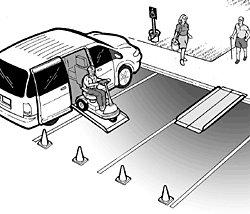
Three standard parking spaces are converted into an accessible parking space with an
access aisle. Cones mark the access aisle and a temporary curb ramp with edge
protection connects to an accessible route to the polling place.
B. Passenger Drop-Off Areas
Typical Issues
Some voters with disabilities will be driven to the polling place and dropped off
near an entrance in a passenger drop-off area. If the polling place is served by
passenger drop-off areas, then at least one drop-off area must be accessible. An
accessible drop-off area, also known as an accessible passenger loading zone,
must have a level access aisle, adjacent and parallel to the vehicle space. Where a
curb separates the vehicle space from the access aisle or the access aisle from an
accessible route, a curb ramp must be provided so people with disabilities can get
to the accessible route leading to the accessible entrance.
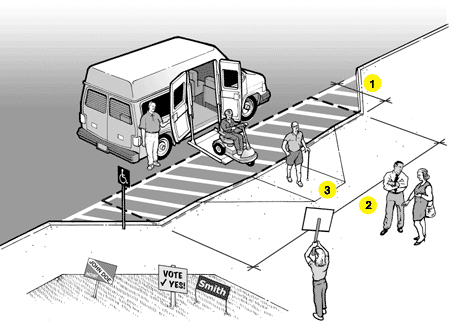
Accessible Passenger Drop-off and Loading Area
Notes:
1. Access aisle depth is at least 5 feet.
2. Access aisle length is at least 20 feet.
3. Curb ramp connects access aisle to the accessible route to the accessible entrance of the polling place.
The access aisle may be at the street level or at sidewalk level. If it is at the sidewalk level,
a curb ramp is provided between the street and the sidewalk. If the access aisle is at the
street level, the curb ramp is provided between the access aisle and the sidewalk
(as shown).
Passenger Drop-Off Areas Checklist
If a passenger loading area is provided, you should answer the following questions.
B1. Is a relatively level (1:50 or 2% maximum slope in all directions) access aisle provided
adjacent and parallel to the side of the vehicle pull-up area? [ADA Stds 4.6.6]
Yes _____ No _____
If No, look for another relatively level location that is on an accessible route.
B2. Is the vehicle space relatively level (2% maximum slope in all directions)?
Yes _____ No _____
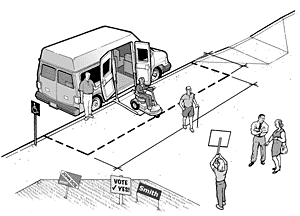
B3. Is the area for the access aisle at least 5-feet wide and 20-feet long? [ADA Stds 4.6.6]
Note: Unlike an accessible parking space, the surface for the access aisle does not have to be marked or striped.
Yes _____ No _____
B4. Is the vertical height for the vehicle route to the loading zone, the drop off area,
and the exit at least 114 inches (9 feet 6 inches) in height? [ADA Stds 4.6.5]
Yes _____ No _____
B5. Is a curb ramp provided between the vehicle pull up area and the access aisle (see figure above) or the access aisle
and the accessible route (see figure on page 9) to the accessible entrance? [ADA Stds 4.6.6]
Yes _____ No _____
If No, is there another area with a curb ramp connected to an accessible route that could serve as the drop-off area?
Yes _____ No _____
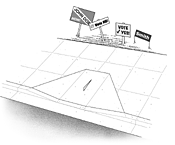
B6. If a curb ramp is provided, is the slope of the ramp surface (not counting the side flares) no more than 1:12?
[ADA Stds 4.7.2]
Yes _____ No _____
B7. Is the width of the curb ramp surface at least 36 inches?
[ADA Stds 4.7.3]
Yes _____ No _____
B8. Does an accessible route connect the curb ramp to the accessible entrance?
[ADA Stds 4.1.2(1)]
Temporary Solutions for Election Day
Passenger Drop-Off Areas
Problem:
A passenger drop-off and loading zone is provided but there is no curb ramp between the vehicle area
and the sidewalk leading to the accessible polling place entrance.
Suggestion: Provide a portable ramp with edge protection in an area where the vehicle area and the sidewalk
are relatively level. The curb ramp must connect to an accessible route to the accessible polling place entrance.
If the drop-off and loading zone is not relatively level, consider relocating the accessible drop-off area and
using one parking space next to the area where accessible parking is located to provide an accessible drop-off
and loading zone. Cones or another temporary barrier may be needed to keep the parking space clear.

A portable ramp with edge protection is used to provide an accessible route
from the drop-off and loading area to the accessible polling place entrance.
C. Sidewalks and Walkways
Part 1. Typical Issues for Voters Who Use Wheelchairs, Scooters or Other Mobility Aids
There must be at least one exterior accessible route that connects accessible passenger drop-off areas, accessible parking spaces, and other accessible elements, for example a route from a bus stop to an accessible building entrance. The accessible route is essential for people who have difficulty walking or who use wheelchairs or other mobility aids to get to the accessible entrance of the polling place.
An accessible route is at least 36 inches wide and may narrow briefly to 32 inches wide where utility poles, post-mounted signs, furniture, and doorways are located along an accessible route. Abrupt level changes, steps, or steeply sloped sidewalks cannot be part of an accessible route. Where ramps are used, they cannot be steeper than 1:12. Ramps with a vertical rise of more than 6 inches must have handrails on both sides. Ramps must also have edge protection to stop wheelchairs from falling off the sides, and level landings at the top and bottom of each segment and where a ramp changes direction.
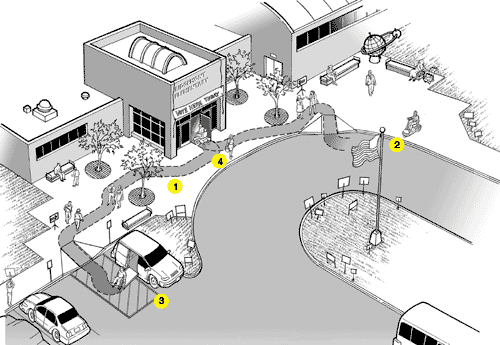
An accessible entrance to a polling place with accessible parking and an accessible drop-off area.
Notes:
1. Accessible route.
2. Accessible drop-off area.
3. Accessible parking with van accessible parking space.
4 Accessible entrance to polling place.
Sidewalks and Walkways Checklist - Voters with Mobility Disabilities

C1-1. Is an accessible route provided from accessible parking spaces to the accessible entrance of the building?
[ADA Stds 4.1.2(1), 4.3]
Yes _____ No _____
Note: If the accessible route crosses a vehicular route, a marked crosswalk should be used.
Yes _____ No _____
C1-2. Is an accessible route provided from public sidewalks and public transportation stops on the polling site (if
provided) to the accessible entrance of the building? [ADA Stds 4.1.2(1)]
Yes _____ No _____
C1-3. Is the accessible route at least 36 inches wide?
If No, the accessible route may narrow to 32 inches wide for up to 2 feet in length.
Yes _____ No _____
C1-4. Is the accessible route free of steps and abrupt level changes over 1/2 inch?
Note: Level changes between 1/4 inch and 1/2 inch should be beveled.
Yes _____ No _____
C1-5. Where an accessible route crosses a curb is a curb ramp provided? If yes,
Yes _____ No _____
5a. Is the ramp surface at least 36 inches wide, excluding flared sides?
[ADA Stds 4.7.3]
Yes _____ No _____
5b. Is the slope (up or down the ramp) no more than 1:12? [ADA Stds 4.7.2]
Note: 1:12 is one inch of vertical height for 12 inches of horizontal distance.
Yes _____ No _____
C1-6. If the slope of part of the accessible route is greater than 1:20, does this part
meet the following requirements for an accessible ramp?
Yes _____ No _____
6a. Is the ramp slope no greater than 1:12? [ADA Stds 4.8.2]
Note: For existing ramps, the slope may be 1:10 for a 6 inch rise and 1:8 for a 3
inch rise in special circumstances (see ADA Stds 4.1.6(3)).
Yes _____ No _____
6b. Is the ramp width, measured between handrails, at least 36 inches?
[ADA Stds 4.8.3]
Yes _____ No _____6c. Does the ramp have a level landing at the top and bottom of each ramp
section that is at least 60 inches long? [ADA Stds 4.8.4]
Note: The level landing may be part of the sidewalk or walking surface.
Yes _____ No _____
6d. If a ramp is more than 30 feet long, is a level landing at least 60 inches long
provided every 30 feet of horizontal length? [ADA Stds 4.8.4]
Note: When the running slope is less than 1:16 and more than 1:20, each ramp
segment may be up to 40 feet long followed by a level landing.
Yes _____ No _____
6e. Is a level landing, at least 60 inches by 60 inches, provided where a ramp
changes direction? [ADA Stds 4.8.4]
Yes _____ No _____
6f. Are the handrails mounted between 34 and 38 inches above the ramp surface?
[ADA Stds 4.8.5]
Yes _____ No _____
6g. If the ramp or landing has a vertical drop-off on either side of the ramp, is
edge protection provided? [ADA Stds 4.8.7]
Yes _____ No _____
Accessible Ramp Features
Notes:
1. At least 36 inches
between handrails
2. Top landing part of walk
3. Bottom landing part of
walk
4. Handrail height 34 to 38
inches
5. Edge protection
Temporary Solutions for Election Day
Sidewalks and Walkways - Voters with Mobility Disabilities
Problem One:The sidewalk connecting parking to the polling place entrance is too steep to be accessible.
Suggestion: Check to see if there is another sidewalk that provides an accessible route to the accessible entrance.
Sometimes there is a less direct route that can serve as the accessible route.
Problem Two:
The accessible route crosses a curb and no curb ramp is provided.
Suggestion: Install a portable ramp with edge protection.

A portable ramp with edge protection is installed over a curb to provide an accessible route.
Problem Three:
One or two steps are part of the walkway leading to the accessible entrance.
Suggestion: Install a portable ramp no steeper than 1:12 slope with edge protection and handrails.
C. Sidewalks and Walkways
Part 2. Typical Issues for Voters Who Are Blind or Have Low Vision
Objects that are wall-mounted, that project into a pedestrian route from the side,
or that are overhead must be located so that people who are blind or who have
low vision will either detect the objects before they run into them or safely pass
under them. Examples include handrail extensions on stairs and ramps, post or wall-mounted signs,
outdoor drinking fountains, and tree limbs that are lower than 80 inches above the walk.
Pedestrian routes open to voters, such as sidewalks, courtyards, and plazas, must be free of
overhanging objects that are less than 80 inches above the route. Objects more than 27 inches
and less than 80 inches above the route that protrude from the side more than 4 inches are also a hazard.
Because people can walk on any sidewalk, not just the accessible routes, all exterior pedestrian routes
serving or leading to the voting area must be checked. The following checklist applies to sidewalks
and walkways leading to the polling place and voting area.
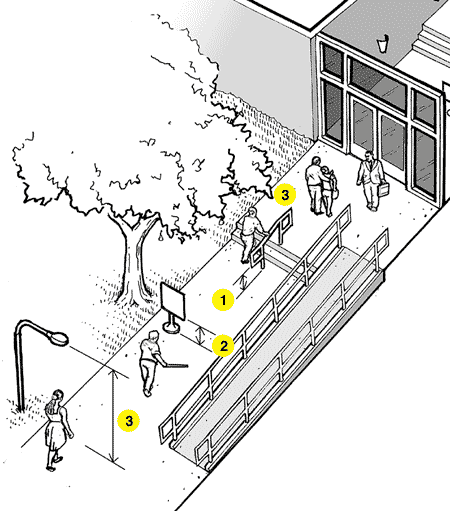
Common objects along pedestrian routes to a polling place that can
be hazards to people who are blind or have low vision.
Notes:
1. The bottom of the handrail extensions turn down so a person who is blind
or has low vision can detect the hazard before running into it.
2. Signs or other objects in the pedestrian route can be a hazard if the bottom
is more than 27 inches but less than 80 inches above the route.
3. Objects that overhang the pedestrian route must be at least 80 inches above the route.
C2-1. Are all sidewalks and walkways to the voting area free of any objects
(e.g., wall-mounted boxes, signs, handrail extensions, trees) with bottom edges that
are higher than 27 inches but less than 80 inches above the walkway and that
extend more than 4 inches into the sidewalk or walkway? [ADA Stds 4.4, 4.2.1(3), 4.1.3(2)]
Yes _____ No _____
If No, can the object be lowered, removed, or modified or can the route be changed to avoid the object?

This wall-mounted box is mounted too high to be detectable by a person who is blind.
Placing an object, like this sign, under the box provides a way to warn the person before
they walk into the side of the box.
C2-2. Are the undersides of exterior stairs enclosed or protected with a cane detectable
barrier so that people who are blind or have low vision will not hit their heads on the underside?
[ADA Stds 4.4.2]
Yes _____ No _____
If No, can a barrier or enclosure be added below the stair or can the route be relocated away from the stair?
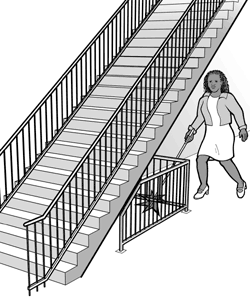
When the underside of a stair is open, it is a hazard to people who are blind
or have low vision. Enclosing the area below the stair or installing a cane-detectable
barrier helps the person to stop before hitting her head.
C2-3. Are all objects that hang over the pedestrian routes 80 inches or more above the route?
If No, can the objects be removed or relocated, or can a detectable object be added below?
Yes _____ No _____

At least 80 inches above walk
Temporary Solutions for Election Day
Sidewalks and Walkway Hazards
Problem One: Branches or other objects over a walkway or pedestrian route are lower than 80
inches above the walk.
Suggestion: Prune the branches or remove the items that are hanging below 80 inches.
Another approach is to install a detectable barrier under the item that is too low. The
detectable barrier or object must be within the detectable range of 27 inches or less
above the route.
Problem Two: One or more objects protrude too far from the side into the circulation path causing
a hazard for people who are blind or who have low vision.
Suggestion: When people who are blind or who have low vision use a cane to detect
hazards, objects located at 27 inches or lower are detectable. When an object is located
more than 27 inches off the ground it is a hazard if the object protrudes more than 4
inches into the circulation path. To make a protruding object detectable:
Place an object or a barrier below the protruding object in the cane-detectable area not
more than 27 inches above the floor.
If the protruding object can be moved, lower the object so its bottom is within the cane detectable
area (not more than 27 inches above the floor).
Prune or alter the protruding object so it does not protrude over the path.
Entering the Polling Place
D. Building Entrance
Typical Issues
An accessible polling place must have at least one accessible entrance.
The accessible entrance must be connected to an accessible route.
An accessible entrance must provide at least one accessible door with
maneuvering space, accessible door hardware, and enough clear width to
allow people who use crutches, a cane, walker, scooter or wheelchair to use it.

Notes:
1. Accessible entrance to the polling place.
2. Accessible route connecting accessible parking and drop-off area (if provided) to the accessible entrance.
If the accessible entrance is not the main entrance to the polling place, then signs
must be located at inaccessible entrances to the polling place to direct voters to
the accessible entrance. The accessible entrance must remain open when
the polling place is open.
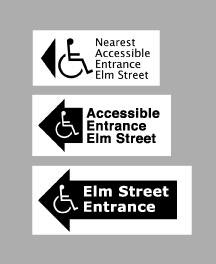
Examples of signs for inaccessible polling
place entrances directing a voter to the
accessible entrance.
Building Entrance Checklist
D1. Is there at least one accessible entrance connected to an accessible route?
[ADA Stds 4.1.3(1)]
Notes: If this entrance is not the main entrance, it needs to be kept unlocked during
voting hours.
If there are inaccessible entrances serving the polling place, signs will be needed at
inaccessible entrance(s) to direct voters to the nearest accessible entrance.
Yes _____ No _____
D2. Does at least one door or one side of a double leaf door at the accessible entrance
provide at least 32 inches clear passage width when the door is open 90 degrees?
[See figure 24 in the appendix at the back of the checklist]
Yes _____ No _____
If No, does another entrance have an accessible door or can both doors be propped
open during voting? Other possible solutions are to enlarge the door opening, use a
swing clear hinge, or, if a double leaf door, use uneven width doors.
D3. Is the door hardware (e.g., lever, pull, panic bar) usable with one hand without
tight grasping, pinching, or twisting of the wrist? [ADA Stds 4.13.9]
Yes _____ No _____
If No, leave door propped open, add new accessible hardware, or adapt/replace
hardware.

Examples of handles and door hardware that can be used without tight grasping, pinching, or twisting.
D4. On the pull side of the door, is there at least 18 inches clearance provided to the
side of the latch if the door is not automatic or power-operated? [ADA Stds 4.13.6, figure 25]
Note: The maximum threshold height is 1/2 inch for new construction.
If No, leave the door propped open, install a power operator, or look for another
accessible entrance.
Yes _____ No _____
D5. If there is a raised threshold, is it no higher than 3/4 inch at the door and beveled
on both sides? [ADA Stds 4.1.6(3)(d)(ii), 4.13.8]
Yes _____ No _____
If No, replace threshold with one with beveled sides or add sloped insert to threshold.
D6. If an entry has a vestibule, is there a 30-inch by 48-inch clear floor space inside the
vestibule where a wheelchair or scooter user can be outside the swing of a hinged door?
[ADA Stds 4.13.7]
Yes _____ No _____
If No, leave the inner door open or remove inner door, add power operators to both doors so they
open at the same time or, modify the vestibule.

Insufficient space between doors
makes the alcove inaccessible.

Minimum alcove depth of 48 inches if both doors open out

Minimum alcove depth of 48 inches + door width when door swings into alcove
Temporary Solutions for Election Day
Accessible Entrance to Polling Place
Problem One:
One or two steps at the entrance prevent access.
Suggestion: If another entrance is accessible and on an accessible route from accessible parking,
designate it as the accessible entrance and install a directional sign at the main entrance directing
voters to the accessible entrance. Keep the accessible entrance unlocked during voting hours.
If another accessible entrance is not available, install a temporary ramp with edge protection and handrails.
Problem Two:
There is a small step at the entrance.
Suggestion: Install a short temporary ramp to provide a smooth transition.
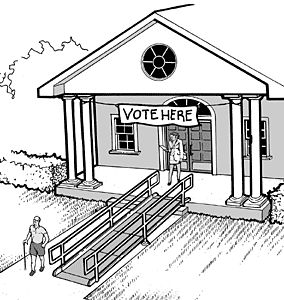
Problem Three:
Entrance door threshold has an abrupt change in level of more than 1/4 inch and no beveled sides.
Suggestion: If the threshold is not more than 3/4 inches high, add beveled surfaces to both sides
of the threshold or replace with a new threshold that is no more than 1/2 inch high and that has beveled sides.
Problem Four:
Entrance door to the building is heavy and difficult to open.
Suggestion: Keep the door propped open or station volunteers near the door to open it for voters.
Problem Five:
Door handle and/or latch at the entry door is not accessible.
Suggestion: These are three typical solutions: add an accessible pull or handle to the outside
of the door and leave the door unlatched, or install an accessible door handle and hardware,
or leave the door propped in an open position.
E. Hallways and Corridors
Part 1. Typical Issues for Voters Who Use Wheelchairs, Scooters, or Other Mobility Devices
The interior accessible route connects the accessible entrance with the voting area. Typically made up
of hallways, corridors,and interior rooms and spaces, the accessible route is essential for people who
have difficulty walking or who use wheelchairs or other mobility aids to get to the voting area.
An accessible route is at least 36 inches wide and may narrow briefly to 32 inches wide where the route
passes through doors or next to furniture and building elements. High thresholds, abrupt level changes, steps,
or steeply sloped hallways cannot be part of an accessible route. Where ramps are used, they cannot be
steeper than 1:12. Ramps with a vertical rise of more than 6 inches must have handrails on both sides.
Ramps must also have edge protection to stop wheelchairs from falling off the sides, and level landings at
the top and bottom of each segment and where a ramp changes direction.
Where an accessible route is different from the route used by most voters, signs will be needed at key
decision points to direct voters with disabilities to the voting area.
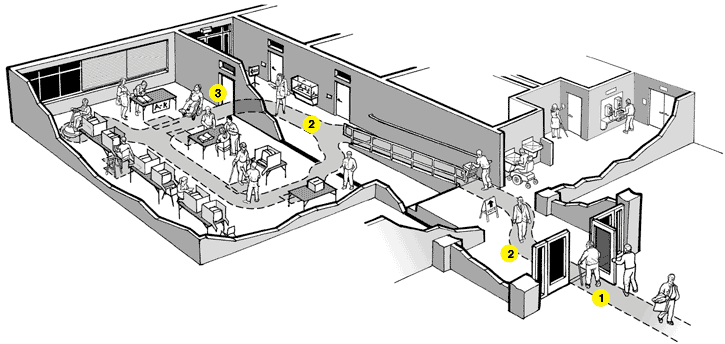
Interior of a polling place showing the accessible route from the accessible entrance to the voting area.
Notes:
1. Accessible entrance
2. Accessible route connects the
accessible entrance with the voting area.
3. Accessible door to the voting area
Halls and Corridors Checklist - Voters with Mobility Disabilities
E1-1. Is there an accessible route, at least 36 inches wide that connects the accessible
entrance to the voting area (the accessible route may narrow to 32 inches wide for up
to 2 feet in length)?
Yes _____ No _____
E1-2. Is the accessible route free of steps and abrupt level changes over 1/2 inch (level
changes between 1/4 inch and 1/2 inch should be beveled)? [ADA Stds 4.1.3(1), 4.3.8]
Yes _____ No _____
E1-3. Does the route from the accessible entrance to the voting area change levels
using a ramp, lift or elevator?
Yes _____ No _____
If no, go to question E1-7.
3a. If yes, is a ramp or sloped hallway provided?
Yes _____ No _____
If yes, go to question E1-4.
Note: A ramp, lift, or elevator can be used to provide access to floor levels.
3b. Is an elevator provided or lift provided?
Yes _____ No _____
If an elevator is provided, go to question E1-5. If a lift is provided, go to question E1-6.
E1-4. Where the slope of the accessible route is greater than 1:20, does this part of
the accessible route meet the following requirements for an accessible ramp?
Yes _____ No _____
4a. Is the slope no greater than 1:12? [ADA Stds 4.8.2]
Yes _____ No _____
Note: For existing ramps, the slope may be 1:10 for a 6 inch rise and 1:8 for a 3 inch
rise in special circumstances, see ADA Standards 4.1.6(3).
4b. Is the ramp width, measured between handrails, at least 36 inches?
[ADA Stds 4.8.3]
Yes _____ No _____
4c. Are the handrails mounted between 34 and 38 inches above the ramp surface?
[ADA Stds 4.8.5]
Yes _____ No _____
4d. If a ramp is more than 30 feet long, is a level landing at least 60 inches long
provided every 30 feet of horizontal length? [ADA Stds 4.8.4]
Yes _____ No _____
Note: When the running slope is less than 1:16 and more than 1:20, each ramp
segment may be up to 40 feet long followed by a level landing.
4e. Does the ramp have a level landing at the top and bottom of each ramp section
that is at least 60 inches long? [ADA Stds 4.8.4]
Yes _____ No _____
Note: The level landing may be part of the sidewalk or walking surface.
4f. Is a level landing, at least 60 inches by 60 inches, provided where a ramp
changes direction? [ADA Stds 4.8.4]
Yes _____ No _____
4g. If the ramp or landing has a vertical drop-off on either side of the ramp, is
edge protection provided? [ADA Stds 4.8.7]
Yes _____ No _____
E1-5. Is an elevator provided to access the voting area level?
Yes _____ No _____
5a. Are the elevator call buttons mounted in an accessible location with the
centerlines at 42 inches above the floor? [ADA Stds 4.10.3]
Yes _____ No _____
5b. Does the floor area of the elevator car provide space for wheelchair users to
enter, reach the controls, and exit the car? [ADA Stds 4.10.9]
Note: See Figure 22 for acceptable floor and opening dimensions. Floor dimensions of
at least 48 inches by 48 inches may be allowed in existing facilities built before the ADA
went into effect.
5c. Are the highest floor control buttons in the elevator cab mounted no more
than 54 inches above the floor for a side reach or 48 inches for forward reach?
Yes _____ No _____
5d. Are raised letters and Braille characters used to identify each floor button and
each control? [ADA Stds 4.10.12]
Yes _____ No _____
5e. Are signs mounted on both sides of the elevator hoistway door opening that
designate the floor with 2-inch minimum-height raised letters and Braille
characters centered at 60 inches above the floor? [ADA Stds 4.10.5]
Yes _____ No _____
5f. Is the elevator equipped with audible tones or bells or verbal annunciators that
announce each floor as it is passed? [ADA Stds 4.10.13]
E1-6. If a wheelchair lift is provided, does it meet the following requirements:
6a. Is the lift operational at the time of the survey?
Yes _____ No _____
6b. Is the change in level from the floor to the lift surface ramped or beveled?
Yes _____ No _____
6c. Is there at least a 30-inch by 48-inch clear floor space on the wheelchair lift?
Yes _____ No _____
6d. Does the lift allow a wheelchair user unassisted entry, operation, and exit?
Yes _____ No _____
6e. Are the controls and operating mechanisms mounted no more than 54 inches
above the floor for a side reach or 48 inches for a forward reach?
Yes _____ No _____
6f. Are the controls and operating mechanisms usable with one hand without tight
grasping, pinching, or twisting?
E1-7. At each location on the way to the voting area where the accessible route passes
through a door or doors, does at least one door meet the following requirements?
Yes _____ No _____
7a. Is the clear width for the door opening at least 32 inches measured when the
door is open 90 degrees? [ADA Stds 4.1.3(7), 4.13.5]
Yes _____ No _____
7b. Is the door hardware (e.g., lever, pull, push, panic bar) usable with one hand,
without tight grasping, pinching, or twisting of the wrist, to allow people who may
not be able to easily use one or both hands to fully operate the hardware?
[ADA Stds 4.13.9]
Yes _____ No _____
A clear floor space on the latch side of the door (pull side) allows a person using a wheelchair
or scooter to pull the door open and then enter. The size of the clear floor space varies depending
on the direction of approach (shown by the arrows) and the door swing.
7c. Is there clear maneuvering floor space in front of each accessible door (see
Figure 25 in the appendix for measurements) and on the pull side, is there at least
18 inches clear floor space beyond the latch side of the door (see space
configurations in Figure 25)? [ADA Stds 4.13.6]
7d. Is no more than 5 pounds force needed to push or pull open the accessible
door?
Yes _____ No _____
Note: Fire doors are still considered to be accessible if they have the minimum
opening force allowable by the appropriate administrative authority.
Yes _____ No _____
7e. If the answers to questions (b) thru (d) are no, can the door be propped open
to provide an accessible route on election day?
Temporary Solutions for Election Day
Interior Hallways and Corridors to Voting Area
Problem 1:
One or more steps along hallway to voting area block access.
Suggestion: Install a portable ramp with edge protection and handrails as shown in the figure
or relocate the accessible voting to another area that is on an accessible route.
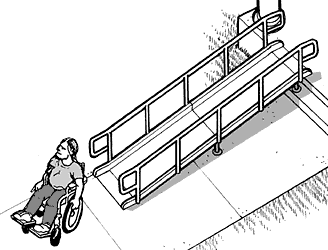
A portable ramp with edge protection and handrails is placed
over stairs to provide an accessible route on Election Day.
Problem 2:
Voting area is not on an accessible route and cannot be made accessible.
Suggestion: Look for another area where accessible voting may be provided.
For example, if the living room of a private home used for voting is up several steps,
perhaps the garage may be accessible when entered from the driveway.
Or, if a church’s basement is used as a polling place and it is not accessible,
perhaps one of the ground floor rooms could be used as the accessible voting area.

An accessible voting station is provided on an accessible level in a facility where voting occurs downstairs.
E. Hallways and Corridors
Part 2. Typical Issues for Voters Who are Blind or Who Have Low Vision
People who are blind or have low vision may walk along any route to access the voting area,
not just the accessible routes.That means pedestrian routes open to voters serving or
leading to the voting area, such as hallways, corridors and the voting space, must be free of objects
that cannot be detected by a person who is blind or visually impaired. Objects that are wall-mounted,
that project into a pedestrian route from the side, or that are overhead must be located so that
voters who are blind or who have a visual impairment will either detect the objects before they run
into them or safely pass under them. These routes must be free of overhanging objects that are less
than 80 inches above the floor and side objects that protrude into the route more than 4 inches when
the bottom of the object is more than 27 inches above the floor. Items to watch for include wall-mounted
fire extinguishers and wall-mounted display cases when the bottom is more than 27 inches above
the floor, wall sconces and light fixtures that protrude more than 4 inches off the wall, and open staircases,
exit signs,overhead signs, banners, and arched doorways that are lower than 80 inches above the floor.
The following checklist applies to pedestrian routes serving or leading to the voting area.

Overhead and wall-mounted objects that may be hazards along a pedestrian route.
Notes:
1. Wall-mounted drinking fountains are a hazard when the front projects more than
4 inches beyond the wall and the bottom is more than 27 inches above the floor.
2. Wall-mounted objects cannot project more than 4 inches beyond the wall if the
bottom is not in the cane-detectable area below 27 inches off the floor.
3. Overhead objects must be at least 80 inches off the floor.
Halls and Corridors Checklist - Voters who are Blind or Who Have Low Vision
E2-1. Are pedestrian routes leading to or serving the voting area free of objects that
protrude from the side more than 4 inches into the route with the bottom of the object
more than 27 inches above the floor? [ADA Stds. 4.4]
Note: These objects may be wall mounted or free standing. Items to check
include wall-mounted fire extinguishers, light fixtures, coat hooks, shelves,
drinking fountains, and display cases. If No, list the objects that are a hazard
and their location. Placing a detectable object on the floor below each object
may remove the hazard for election day.
Yes _____ No _____

If the bottom of an object is not more than 27 above the floor,
it may extend an unlimited amount from the wall.
E2-2. Are pedestrian routes leading to or serving the voting area free of overhead
objects with the bottom edge lower than 80 inches above the floor?
Yes _____ No _____
If No, list the objects that are a hazard and their location. Placing a detectable object on
the floor below each object may remove the hazard for election day.
E2-3. If provided, are the interior stairs along these routes built so that people who
are blind or visually impaired cannot hit their heads on the underside (i.e., protected
with a cane-detectable warning or a barrier that prevents travel into the area with less
than an 80-inch-high head clearance)? [ADA Stds 4.4.2]
Yes _____ No _____
Temporary Solutions for Election Day
Hallways and Corridors - Voters Who are Blind or Who Have Low Vision
Problem One:
Wall-mounted display case is a protruding object hazard because it is more than 4 inches
from the wall and the bottom of the case is more than 27 inches above the floor.
Suggestion: Place a detectable object or skirting below the case. The bottom of
the skirting or detectable object must be no higher than 27 inches above the floor.
Problem Two:
Ceiling or wall-mounted television monitor has less than 80 inches of clearance between the
floor and the bottom of the unit.
Suggestion: Place a detectable object below the unit (no more than 27 inches
above the floor) so a voter who is blind will not walk into the television.
Problem Three:
The bottom of a stair is open and voters who are blind or who have low vision can hit their
heads on the underside of the stair.
Suggestion: Provide a detectable fence or other object so voters cannot walk
under the stair.
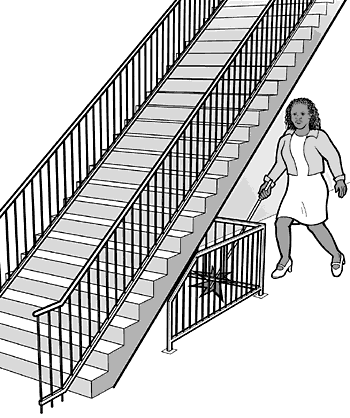
A detectable fence placed under this stair keeps people from
running into the bottom of the open stair.
Using the Polling Place
F. Voting Area
Typical Issues
The accessible voting area must be on an accessible route and have an accessible entrance
and adequate circulation and maneuvering space for voters who use wheelchairs or scooters
or who walk with mobility aids.
An accessible route must connect the accessible building entrance to the accessible voting area,
which includes voter check-in and the location of the accessible voting machines. The survey should
also identify any protruding objects (wall-mounted or overhead) along the circulation route to voter check-in
and the voting area.
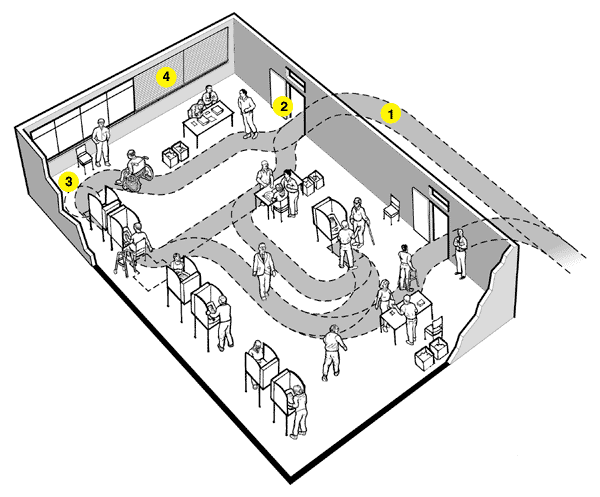
Notes:
1. Accessible route connects the building entrance with the voting area, including
voter check-in and accessible voting machine.
2. Accessible door or doorway to voting area
3. Turning space at accessible voting machine
4. Blinds closed on windows behind check-in so voters who read lips can
communicate with the voting staff.
Voting Area Checklist
1. Is there an accessible entrance to the voting area?
Yes _____ No _____
2. Within the voting area, is adequate space available on the accessible level for check-in
tables, a voting demonstration area (if provided), and at least one accessible voting station?
Yes _____ No _____
3. Is the voting area free of objects that protrude from the side more than 4 inches into the
route with the bottom of the object more than 27 inches above the floor? [ADA Stds. 4.4]
Note: These objects may be wall mounted or free standing. Items to check include
wall-mounted fire extinguishers, light fixtures, coat hooks, shelves, and display cases.
Yes _____ No _____
4 Is the voting area free of overhead objects that voters may pass under with the
bottom edge lower than 80 inches above the floor?
Yes _____ No _____
Appendix
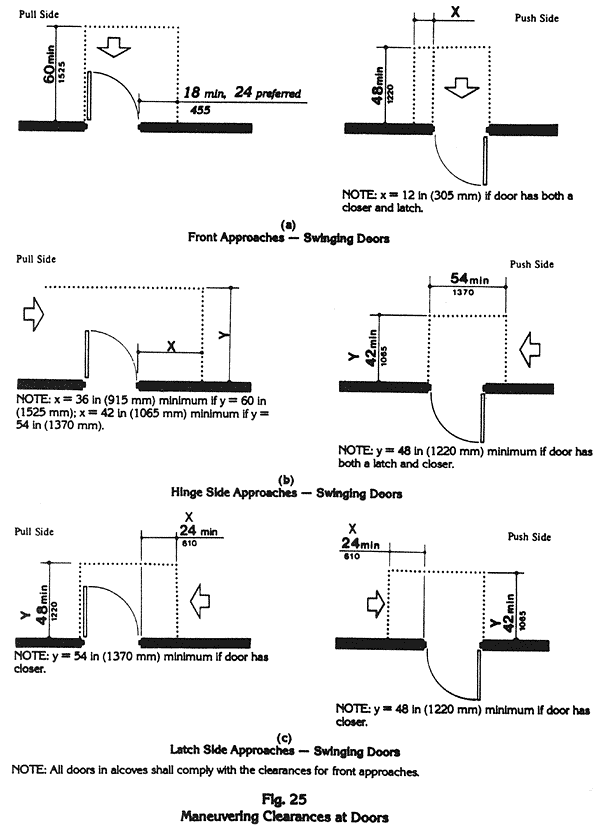
![]()
Last updated October 09, 2008

